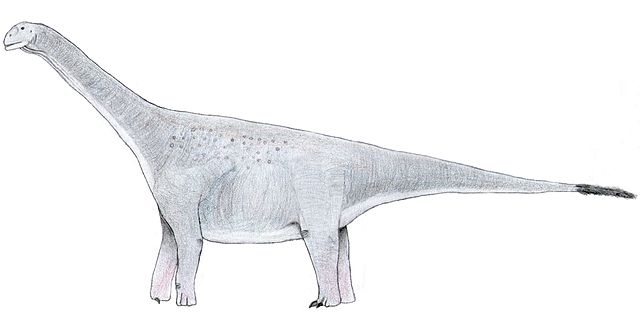Top Qs
Timeline
Chat
Perspective
Turiasaurus
Extinct genus of dinosaurs From Wikipedia, the free encyclopedia
Remove ads
Turiasaurus (meaning "Turia lizard") is a genus of sauropod dinosaurs. It is known from a single fossil specimen representing the species Turiasaurus riodevensis, found in the Kimmeridgian Villar del Arzobispo Formation of Teruel, Spain.
Remove ads
Description

Turiasaurus is believed to be the largest dinosaur ever found in Europe, and is among the largest dinosaurs known. It was originally estimated at over 30 metres (98 ft), possibly around 36–39 metres (118–128 ft) in length and with a weight of 40–48 t (44–53 short tons).[1] More recent estimates suggest a length of 21–30 metres (69–98 ft) in length, but a comparable weight of 30–50 t (33–55 short tons).[2][3] The length of its skull is 70 centimetres, which is not too large. According to the paleontologist Luis Alcalá, this is because a larger head might have caused Turiasaurus to break its neck.[4]
Phylogenetic analysis shows that Turiasaurus lies outside of the Neosauropoda division and belongs to a new clade, Turiasauria, together with Losillasaurus and Galvesaurus.[1]
Remove ads
History


Fragmentary remains of this animal, including an articulated left forelimb (holotype), skull fragments, teeth, vertebrae and ribs, have been found in terrestrial deposits of the Villar del Arzobispo Formation of Riodeva (Teruel Province, Spain). A forelimb from Portugal[5] is now seen as Zby atlanticus.[6] The type species, Turiasaurus riodevensis, was formally described by Royo-Torres, Cobos & Alcala, in 2006.[1] In the early 2010s, excavations were made east of Madrid that uncovered the most complete fossil of such creatures in the whole world.[7]
Remove ads
References
External links
Wikiwand - on
Seamless Wikipedia browsing. On steroids.
Remove ads

